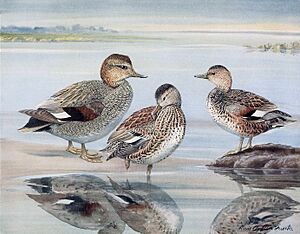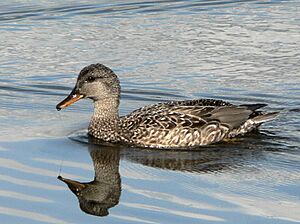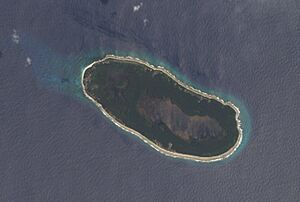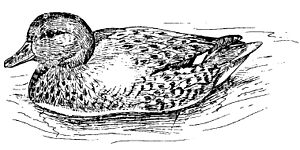Coues's gadwall facts for kids
Quick facts for kids Coues's gadwall |
|
|---|---|
 |
|
| Illustration of a male and female gadwall, with a male Coues's gadwall, by Louis Agassiz Fuertes | |
| Conservation status | |
| Scientific classification |
|
| Kingdom: | Animalia |
| Phylum: | Chordata |
| Class: | Aves |
| Order: | Anseriformes |
| Family: | Anatidae |
| Genus: | Mareca |
| Species: | |
| Subspecies: |
†M. s. couesi
|
| Trinomial name | |
| Mareca strepera couesi (Streets, 1876)
|
|
| Synonyms | |
|
|
The Coues's gadwall (Mareca strepera couesi) was a type of duck that is now extinct. It was also known as the Washington Island gadwall. We only know about this duck from two young birds found on Teraina, a Pacific island in Kiribati. These two specimens are kept at the National Museum of Natural History in Washington, D.C.. The duck was named after Elliott Coues, a famous American scientist.
What Did Coues's Gadwall Look Like?
Scientists know about a male and a female Coues's gadwall. They looked a lot like young common gadwalls. However, they had a black beak with more filtering parts inside. Their feet were also black. They were much smaller than common gadwalls. This smaller size might be because the birds found were not yet fully grown.
The male Coues's gadwall looked like a male common gadwall in its "eclipse plumage." This is when male ducks lose their bright feathers after breeding season. The Coues's gadwall male had some white spots on its chest and back. The female looked like a small common gadwall female. Her main wing feathers were not patterned black. Also, the inner part of her secondary wing feathers was grey, not white.
These ducks were about 40 to 45 centimeters long. This is about the size of a Cape teal or a garganey. Their wing was about 19.9 cm, their beak 3.7 cm, and their tarsus (lower leg bone) 3.6 cm. Since the birds found were not fully grown, they might have grown a bit larger.
Why Did Coues's Gadwall Disappear?
Scientists have different ideas about the Coues's gadwall. Many think it was a smaller type, or subspecies, of the common gadwall. Others believe the two birds found might have just been young common gadwalls. They might have been part of a local group that wasn't really a different kind of duck.
Common gadwalls are known to travel far. They have been seen in places like the Tuamotu Islands and Hawaii. These places are about the same distance from where common gadwalls usually live as Teraina is. So, it's possible the two Coues's gadwalls were just young birds from common gadwalls that flew there. Maybe they settled there after being hurt by hunters.
However, the person who found them, Thomas Hale Streets, wrote that there seemed to be a good number of these ducks. This suggests they might have lived there for a long time. So, they could have been a unique type of duck after all.
The two ducks were found in January 1874. Thomas Hale Streets described this new subspecies in 1876. He reported finding the two young birds in a peat bog, which is a type of wetland.
The main reason for their extinction was likely hunting by settlers. People from Tabuaeran (Fanning Island) hunted many migrant ducks on both Teraina and Tabuaeran every year. A local resident named W. G. Anderson said in 1926 that he never saw native gadwalls on Teraina when he was growing up there around 1900. This means the Coues's gadwall likely disappeared between the mid-1870s and the year 1900.





